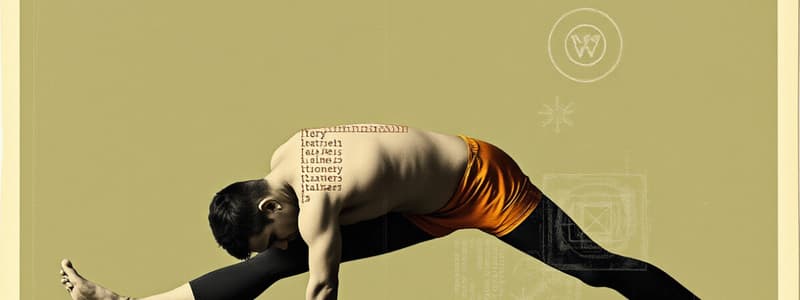Podcast
Questions and Answers
Which statement about active static stretching is true?
Which statement about active static stretching is true?
- It is done only passively.
- It involves the contraction of the muscle being stretched. (correct)
- It is ineffective for improving range of motion.
- It cannot increase actual muscle length.
Why is it recommended to perform passive stretching daily?
Why is it recommended to perform passive stretching daily?
- To avoid tightening of the muscle-tendon.
- To enhance muscular endurance.
- Because muscle-tendon stiffness quickly adapts. (correct)
- To increase muscle length rapidly.
What is a characteristic of proprioceptive neuromuscular facilitation (PNF) stretching?
What is a characteristic of proprioceptive neuromuscular facilitation (PNF) stretching?
- It enhances stretch reflex.
- It increases stretch tolerance over time. (correct)
- It is only effective if done irregularly.
- It does not involve any muscle contraction.
Which statement accurately describes the neurophysiological hypothesis for PNF stretching?
Which statement accurately describes the neurophysiological hypothesis for PNF stretching?
What is the recommended duration and intensity for the static contraction phase during PNF stretching?
What is the recommended duration and intensity for the static contraction phase during PNF stretching?
Which of the following is considered an inappropriate strategy for improving flexibility?
Which of the following is considered an inappropriate strategy for improving flexibility?
What type of stretching involves holding a position that induces muscle tension for 30 seconds?
What type of stretching involves holding a position that induces muscle tension for 30 seconds?
Which stretching technique typically requires a partner and involves a muscle contraction followed by passive stretching?
Which stretching technique typically requires a partner and involves a muscle contraction followed by passive stretching?
Which stretching technique triggers the muscle spindles to induce a stretch reflex?
Which stretching technique triggers the muscle spindles to induce a stretch reflex?
What type of stretching occurs when the targeted muscle group is relaxed during range of motion movements?
What type of stretching occurs when the targeted muscle group is relaxed during range of motion movements?
Viscoelastic creep in the muscle-tendon unit is most likely to happen during which circumstance?
Viscoelastic creep in the muscle-tendon unit is most likely to happen during which circumstance?
What type of stretching involves a combination of slow movements and adjustments at the end of range?
What type of stretching involves a combination of slow movements and adjustments at the end of range?
Flashcards are hidden until you start studying
Study Notes
Stretching Methods and Range of Motion
- No stretching method is definitively superior for increasing range of motion (ROM).
- Common stretching methods include ballistic, dynamic, slow static, and proprioceptive neuromuscular facilitation (PNF).
Flexibility Progression Strategies
- Recommended strategies for flexibility improvement:
- Gradually increasing the duration of stretches.
- Increasing repetitions for each stretching exercise.
- Increasing total accumulated stretching time.
- Pushing beyond pain-free ROM is NOT recommended as a progression strategy.
Types of Stretching
- Active static stretching involves holding a position using active muscle engagement, like bending forward for hamstring tension.
- Proprioceptive neuromuscular facilitation (PNF) often combines a muscle contraction followed by passive stretching, typically involving a partner.
- Ballistic stretching triggers muscle spindles, leading to contraction and increased resistance to stretch.
Stretching Techniques and Responses
- During passive static stretching, the targeted muscle is relaxed while movement is performed by an external force, such as a trainer.
- Viscoelastic creep, or muscle-tendon elongation, is most likely during static stretching held at constant torque.
Muscle Length and Stretching Efficacy
- Active static stretching does not permanently increase actual muscle length.
- Passive stretching requires muscles to remain relaxed, while active stretching involves contraction during the stretch.
Recommendations and Insights on Stretching
- Daily passive stretching is advised to counteract muscle-tendon stiffness adaptation.
- Long-term PNF stretching enhances stretch tolerance, allowing individuals to tolerate more force before pain is felt.
- The neurophysiological hypothesis explains PNF's effectiveness through stretch reflex inhibition.
PNF Stretching Guidelines
- ACSM recommends a static contraction phase in PNF stretching of 3-6 seconds at 50% maximal voluntary contraction (MVC) intensity.
Studying That Suits You
Use AI to generate personalized quizzes and flashcards to suit your learning preferences.





